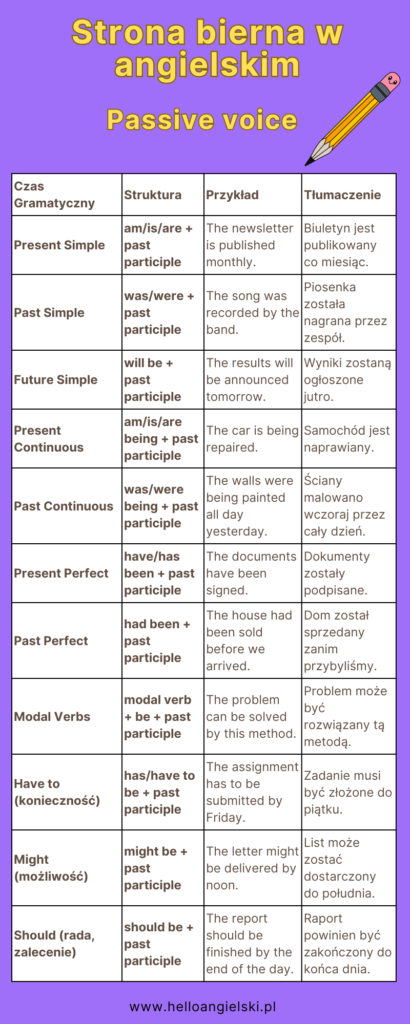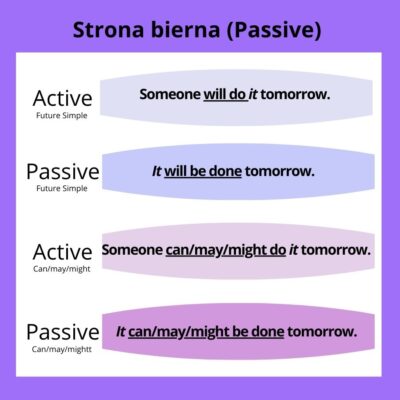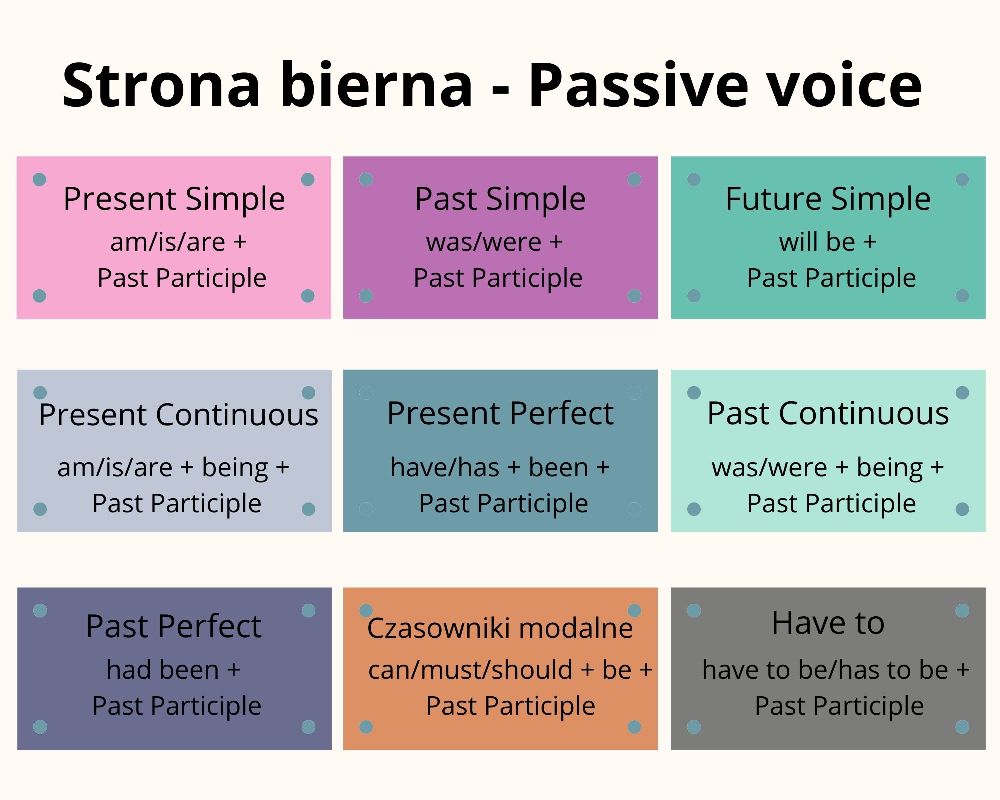Strona bierna w języku angielskim – passive voice
Wstęp
Strona bierna w języku angielskim to konstrukcja gramatyczna, w której zdanie skupia się na odbiorcy czynności lub przedmiocie działania, zamiast na osobie wykonującej czynność. W języku angielskim strona bierna występuje częściej niż w języku polskim, zwłaszcza w języku oficjalnym lub urzędowym.
Struktura zdania w stronie biernej to: podmiot + odpowiednia forma czasownika “to be” + imiesłów bierny + (opcjonalnie) przez/na + wykonawca czynności.
Strona bierna. Zastosowanie
 Strony biernej używamy, gdy bardziej interesuje nas sama czynność, niż osoba, która ją wykonała. Wykonawca czynności może być nieznany lub bliżej nieokreślony. W tłumaczeniach zdań ze strony biernej z języka angielskiego na język polski występują zazwyczaj formy bezosobowe.
Strony biernej używamy, gdy bardziej interesuje nas sama czynność, niż osoba, która ją wykonała. Wykonawca czynności może być nieznany lub bliżej nieokreślony. W tłumaczeniach zdań ze strony biernej z języka angielskiego na język polski występują zazwyczaj formy bezosobowe.
Strona czynna: They speak English here. Mówią tutaj po angielsku.
Strona bierna: English is spoken here. Mówi się tutaj po angielsku.
Strona czynna: They built the castle in 13th century. Zamek zbudowali w XIII wieku.
Strona bierna: The castle was built in 13th century. Zamek został zbudowany w XIII wieku.
Jeżeli podajemy wykonawcę czynności w stronie biernej, używamy przyimka by, np.
This play was writen by Moliere. Sztuka ta została napisana przez Moliere’a.
Jeżeli w stronie biernej chcemy powiedzieć o narzędziu, substancji lub instrumencie, stosujemy przyimek with, np.
The gate will be opened with an electronic chip. Brama będzie otwierana za pomocą elektronicznego chipa.
Jeżeli zdanie zawiera dwa dopełnienia, może mieć dwie konstrukcje w stronie biernej, np.
Strona czynna: They give Susan a lot of homework every day. Codziennie zadają Susan dużo pracy domowej.
Strona bierna: Susan is given a lot of homework every day. Susan codziennie dostaje dużo pracy domowej.
Strona bierna: A lot of homework is given to Susan every day. Dużo pracy domowej zadaje się Susan każdego dnia.
Strona bierna ma szerokie zastosowanie w różnych kontekstach, takich jak biznes, nauka, technologia, sport i wiele innych, gdy autor chce zachować obiektywność lub anonimowość podmiotu, który wykonał czynność. Przykłady:
 The report was written by the marketing department. Raport został napisany przez dział marketingu.
The report was written by the marketing department. Raport został napisany przez dział marketingu.
The article was published in a scientific journal. Artykuł został opublikowany w czasopiśmie naukowym.
The software will be upgraded to the latest version. Oprogramowanie zostanie zaktualizowane do najnowszej wersji.
The race was organized by the local sports association. Wyścig został zorganizowany przez lokalne stowarzyszenie sportowe.
Strona bierna jest również używana, gdy chcemy ukryć lub uniknąć podania osoby wykonującej czynność, zwłaszcza w sytuacjach formalnych, gdzie nie jest istotne, kto dokładnie jest odpowiedzialny. Przykłady:
A decision will be made as soon as possible. Decyzja zostanie podjęta tak szybko, jak to możliwe.
W ten sposób strona bierna umożliwia skupienie się na samym działaniu, zdarzeniu lub przedmiocie, a nie na osobie wykonującej czynność.
Strona bierna. Budowa zdań z przykładami
Stronę bierną tworzymy, stosując odpowiednią formę czasownika BE (forma Be będzie zależna od czasu) oraz trzeciej formy czasownika, czyli imiesłowu biernego (Past Participle).
W przypadku czasownika regularnego trzecią formę Past Participle tworzymy, dodając końcówkę -ed lub -d.
Formy czasowników nieregularnych są podane w zestawieniach, trzeba się ich nauczyć na pamięć
 Present Simple: am/is/are + Past Participle
Present Simple: am/is/are + Past Participle
Past Simple: was/were + Past Participle
Present Continuous: am/is/are + being + Past Participle
Future Simple: will be + Past Participle
Czasowniki modalne: can/must/should/may + be + Past Participle
Present Perfect: have been/has been + Past Participle
Past Continuous: was/were + being + Past Participle
Past Perfect: had been + Past Participle
have to (musieć): have to be/has to be + Past Participle
Czasy takie jak Future Continuous, Present Perfect Continuous oraz Past Perfect Continuous są rzadko stosowane w stronie biernej.
Strona bierna w czasie Present Simple
| Strona czynna Present Simple |
Strona bierna Am/is/are + Past Participle |
| Zdania twierdzące They ask me a lot of questions. She cleans her house every day. They make these bags in Italy. |
Zdania twierdzące I am asked a lot of questions. Her house is cleaned every day. These bags are made in Italy. |
| Zdania pytające Do they ask me a lot of questions? Does she clean her house every day? Do they make these bags in Italy? |
Zdania pytające Am I asked a lot of questions? Is her house cleaned every day? Are these bags made in Italy? |
| Zdania przeczące They don’t ask me a lot of questions. She doesn’t clean her room every day. They don’t make these shoes in Italy. |
Zdania przeczące I am not asked a lot of questions. Her house is not cleaned every day. These shoes are not made in Italy. |
Strona bierna w czasie Past Simple
| Strona czynna Past Simple |
Strona bierna Was/were + Past Participle |
| Zdania twierdzące He wrote this book in 1962. They delivered these parcels yesterday. My father gave me this watch. |
Zdania twierdzące This book was written in 1962. These parcels were delivered yesterday. I was given this watch by my father. |
Zdania pytające Did he write this book in 1962? Did they deliver these parcels yesterday? Did your father give you this watch? |
Zdania pytające Was this book written in 1962? Were these parcels delivered yesterday? Was this watch given by your father? |
| Zdania przeczące He didn’t write this book in 1962. They didn’t deliver these parcels yesterday. My father didn’t give me this watch. |
Zdania przeczące This book wasn’t written in 1962. These parcels weren’t delivered yesterday. I wasn’t given this watch by my father. |
Strona bierna w czasie Present Continuous
| Strona czynna Present Continuous |
Strona bierna Am/is/are + being + Past Participle |
| Zdania twierdzące He is following me. They are playing a beautiful song now. The mechanic is repairing your cars. |
Zdania twierdzące I am being followed. A beautiful song is being played now. Your cars are being repaired by the mechanic. |
| Zdania pytające Is he following me? Are they playing a beautiful song now? Is the mechanic repairing your cars? |
Zdania pytające Am I being followed? Is a beautiful song being played now? Are your cars being repaired by the mechanic? |
| Zdania przeczące He isn’t following me. They aren’t playing a beautiful song now. The mechanic isn’t repairing your cars. |
Zdania przeczące I am not being followed. A beautiful song isn’t being played now. Your cars aren’t being repaired by the mechanic. |
Strona bierna w czasie Future Simple
| Strona czynna Future Simple |
Strona bierna Will be + Past Participle |
| Zdania twierdzące She will sell the house next week. I will never forget you. They will give Mark a new computer. |
Zdania twierdzące The house will be sold next week. You will never be forgotten. Mark will be given a new computer. |
| Zdania pytające Will she sell the house next week? Will I ever forget you? Will they give Mark a new computer? |
Zdania pytające Will the house be sold next week? Will you ever be forgotten? Will Mark be given a new computer? |
| Zdania przeczące She won’t sell the house next week. I won’t forget you. They won’t give Mark a new computer. |
Zdania przeczące The house won’t be sold next week. You won’t be forgotten. Mark won’t be given a new computer. |
Strona bierna – czasowniki modalne: can, could, must, should, may…
| Strona czynna Czasowniki modalne |
Strona bierna Can be/could be/must be… + Past Participle |
| Zdania twierdzące You can charge your phone here. I should tell you the truth. My sister could translate this article. |
Zdania twierdzące Your phone can be charged here. You should be told the truth. This article could be translated by my sister. |
| Zdania pytające Can you charge your phone here? Should I tell you the truth? Could your sister translate this article? |
Zdania pytające Can your phone be charged here? Should you be told the truth? Could this article be translated by your sister? |
| Zdania przeczące You can’t charge your phone here. I shouldn’t tell you the truth. My sister couldn’t translate his article. |
Zdania przeczące Your phone can’t be charged here. You shouldn’t be told the truth. This article couldn’t be translated by my sister. |
Strona bierna w czasie Present Perfect
| Strona czynna Present Perfect |
Strona bierna Have been/has been + Past Participle |
| Zdania twierdzące Lucy has bought a new dress today. Somebody has changed my password. They have cancelled the flights to Barcelona. |
Zdania twierdzące A new dress has been bought today. My password has been changed. The flights to Barcelona have been cancelled. |
| Zdania pytające Has Lucy bought a new dress today? Has anybody changed my password? Have they cancelled the flights to Barcelona? |
Zdania pytające Has a new dress been bought today? Has my password been changed? Have the flights to Barcelona been cancelled? |
| Zdania przeczące Lucy hasn’t bought a new dress today. They haven’t changed my password. They haven’t cancelled the flights to Barcelona. |
Zdania przeczące A new dress hasn’t been bought today. My password hasn’t been changed. The flights to Barcelona haven’t been cancelled. |
Strona bierna w czasie Past Continuous
| Strona czynna Past Continuous |
Strona bierna Was/were + being + Past Partciple |
| Zdania twierdzące She was cooking dinner when we arrived. He was playing the game all day long. They were painting the walls all day yesterday. |
Zdania twierdzące Dinner was being cooked when we arrived. The game was being played all day long. The walls were being painted all day yesterday. |
| Zdania pytające Was she cooking dinner when we arrived? Was he playing the game all day long? Were they painting the walls all day yesterday? |
Zdania pytające Was dinner being cooked when we arrived? Was the game being played all day long? Were the walls being painted all day yesterday? |
| Zdania przeczące She wasn’t cooking dinner when we arrived. He wasn’t playing the game all day long. They weren’t painting the walls all day yesterday. |
Zdania przeczące Dinner wasn’t being cooked when we arrived. The game wasn’t being played all day long. The walls weren’t being painted all day yesterday. |
Strona bierna w czasie Past Perfect
| Strona czynna Past Perfect |
Strona bierna Had been + Past Participle |
| Zdania twierdzące They had built the bridge by April 1995. She had eaten dinner before. He had left the office by then. |
Zdania twierdzące The bridge had been built by April 1995. Dinner had been eaten before. The office had been left by then. |
| Zdania pytające Had they built the bridge by April 1995? Had she eaten dinner before? Had he left the office by then? |
Zdania pytające Had the bridge been built by April 1995? Had dinner been eaten before? Had the office been left by then? |
| Zdania przeczące They hadn’t built the bridge by April 1995. She hadn’t eaten dinner before. He hadn’t left the office by then. |
Zdania przeczące The bridge hadn’t been built by April 1995. Dinner hadn’t been eaten before. The office hadn’t been left by then. |
Wybór między stroną czynną a stroną bierną w języku angielskim
Wybór między stroną czynną a stroną bierną w języku angielskim zależy od kilku czynników, takich jak kontekst, akcentowanie, preferencje stylistyczne i znaczenie, które chcesz przekazać.
 Kiedy używać strony biernej:
Kiedy używać strony biernej:
- Gdy nie jest istotne, kto dokładnie wykonuje czynność: Strona bierna jest przydatna, gdy chcemy skupić się na samym działaniu lub na jego skutkach, a nie na osobie wykonującej czynność. Na przykład: An email was sent yesterday. E-mail został wysłany wczoraj.
- Gdy chcemy uniknąć bezpośredniego oskarżenia lub wskazywania, kto ponosi odpowiedzialność: Strona bierna może być używana, aby złagodzić ton lub zanegować negatywne skutki. Na przykład: The parcel was damaged in transport. Paczka została uszkodzona podczas transportu.
Kiedy używać strony czynnej:
- Gdy chcemy przedstawić osobę wykonującą czynność: Strona czynna pozwala na większe podkreślenie roli osoby wykonującej czynność. Na przykład: Lucy wrote the message. Lucy napisała wiadomość.
- Gdy chcemy wyrazić aktywność lub inicjatywę: Strona czynna jest odpowiednia, gdy chcemy podkreślić, że to osoba wykonuje czynność świadomie lub dobrowolnie. Na przykład: He made a huge mistake. On popełnił ogromny błąd.
Przy tłumaczeniu zdań ze strony biernej z angielskiego na polski, warto wziąć pod uwagę kilka wskazówek:
- W języku polskim często preferuje się użycie strony czynnej, aby zachować odpowiednie brzmienie zdania.
- Należy uważać na tłumaczenie dosłowne, ponieważ nie zawsze strona bierna w angielskim ma swój odpowiednik w polskim. W niektórych przypadkach konieczne może być przekazanie informacji o wykonawcy czynności.
- Dobrze jest również uwzględnić kontekst i intencje autora, aby przekaz był jasny i zrozumiały dla odbiorcy.
Ćwiczenia na stronę bierną
Ćwiczenie na stronę bierną w czasie Present Simple i Past Simple. Zaznacz poprawną formę.
Ćwiczenia ze strony biernej w języku angielskim – PDF do pobrania

